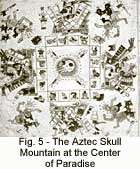
![]() Finally, we return to the Hindu-Tibetan mandalas discussed further above. These mandalas are usually done by painting (on cloth) or, more often, by sandpaintings identical in technique with those of the Navajos and the Pueblos. This type of Hindu mandala such as the ones shown in Fig. 3 above is called Shveta-Dvipa (or “Pure Land”) Mandala or, yet, Kalachakra (“Wheel-of-Time”) Mandala.7
Finally, we return to the Hindu-Tibetan mandalas discussed further above. These mandalas are usually done by painting (on cloth) or, more often, by sandpaintings identical in technique with those of the Navajos and the Pueblos. This type of Hindu mandala such as the ones shown in Fig. 3 above is called Shveta-Dvipa (or “Pure Land”) Mandala or, yet, Kalachakra (“Wheel-of-Time”) Mandala.7
![]() These represent, as do the Amerindian ones just discussed, Mt. Meru as the Central Mountain of Paradise. Most often, Mt. Meru is shown as a four-sided pyramid with the same four colors as those of the Navajo mandalas. In some instances, Mt. Meru is represented as a cone or a four-sided pyramid flanked by its four subsidiary peaks, just as in the Amerindian mandalas.
These represent, as do the Amerindian ones just discussed, Mt. Meru as the Central Mountain of Paradise. Most often, Mt. Meru is shown as a four-sided pyramid with the same four colors as those of the Navajo mandalas. In some instances, Mt. Meru is represented as a cone or a four-sided pyramid flanked by its four subsidiary peaks, just as in the Amerindian mandalas.
![]() These four subsidiary peaks represent the Four Pillars of the Earth. These are placed at its four corners, around the Central Pillar, Mt. Atlas, the Pillar of Heaven. In real terms, the Four Pillars are the Pillars of Hercules, placed two in the Far Occident (Gibraltar) and two at the Far Orient (the Strait of Sunda, in Indonesia). In Egyptian mythology, these Four Pillars are quaintly represented as the four members of Nut (the Sky Goddess) planted on the ground, and two in the Orient, two in the Occident, just as in the present case.
These four subsidiary peaks represent the Four Pillars of the Earth. These are placed at its four corners, around the Central Pillar, Mt. Atlas, the Pillar of Heaven. In real terms, the Four Pillars are the Pillars of Hercules, placed two in the Far Occident (Gibraltar) and two at the Far Orient (the Strait of Sunda, in Indonesia). In Egyptian mythology, these Four Pillars are quaintly represented as the four members of Nut (the Sky Goddess) planted on the ground, and two in the Orient, two in the Occident, just as in the present case.
![]() What else but diffusion can account for this perfect identity in design, in symbolic meaning and even in rendition technique (sandpainting) between the mandalas of the two distant continents? Can anyone really believe that this remarkable coincidence may be attributed to chance or, worse still, to an inborn feature of the human brain, imprinted on the human unconscious, as some will? If so, why do other nations far closer in time and distance than the ones we are discussing never hit on the same ideas and concepts?
What else but diffusion can account for this perfect identity in design, in symbolic meaning and even in rendition technique (sandpainting) between the mandalas of the two distant continents? Can anyone really believe that this remarkable coincidence may be attributed to chance or, worse still, to an inborn feature of the human brain, imprinted on the human unconscious, as some will? If so, why do other nations far closer in time and distance than the ones we are discussing never hit on the same ideas and concepts?
![]() Moreover, if these archetypes were imprinted somehow, except miraculously, this imprint could only be the result of a direct observation of actual facts, shocking enough to get imprinted so deeply in our minds. But then, Atlantis, far more than sheer myth, is pure reality. If so, it is certainly a most memorable one. Hence, one way or the other, in our opinion, the tradition of Atlantis and, hence, of Paradise, can only correspond to actual fact. How else can we accept for its central presence in the traditions of essentially all nations of the world, from the Amazonian jungles to the deserts of North Africa, and from the Indies to the distant European continent?
Moreover, if these archetypes were imprinted somehow, except miraculously, this imprint could only be the result of a direct observation of actual facts, shocking enough to get imprinted so deeply in our minds. But then, Atlantis, far more than sheer myth, is pure reality. If so, it is certainly a most memorable one. Hence, one way or the other, in our opinion, the tradition of Atlantis and, hence, of Paradise, can only correspond to actual fact. How else can we accept for its central presence in the traditions of essentially all nations of the world, from the Amazonian jungles to the deserts of North Africa, and from the Indies to the distant European continent?